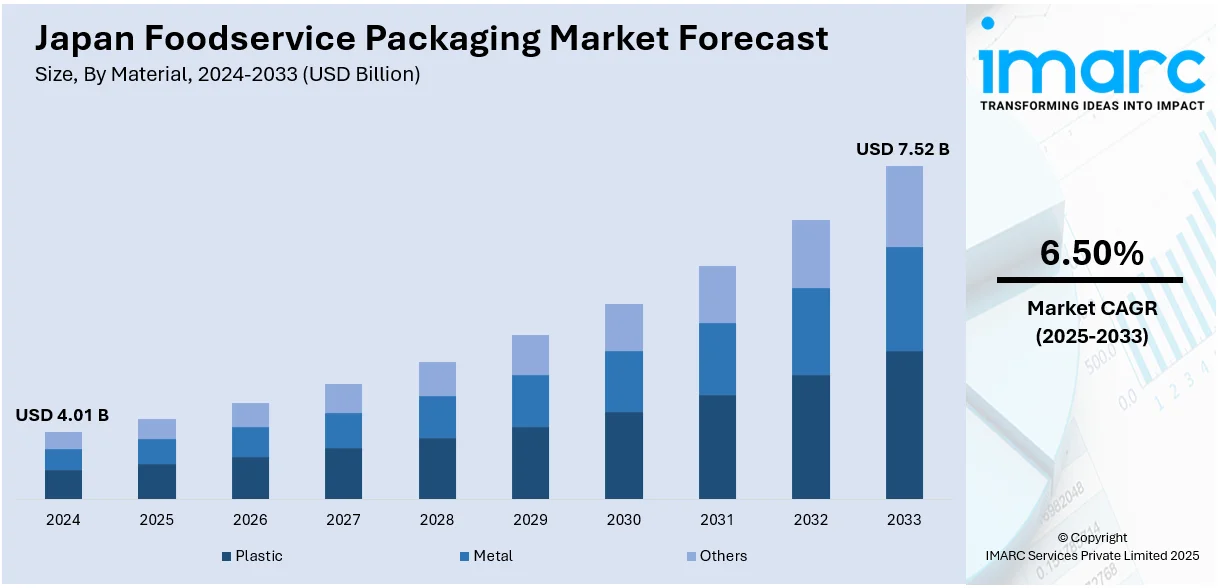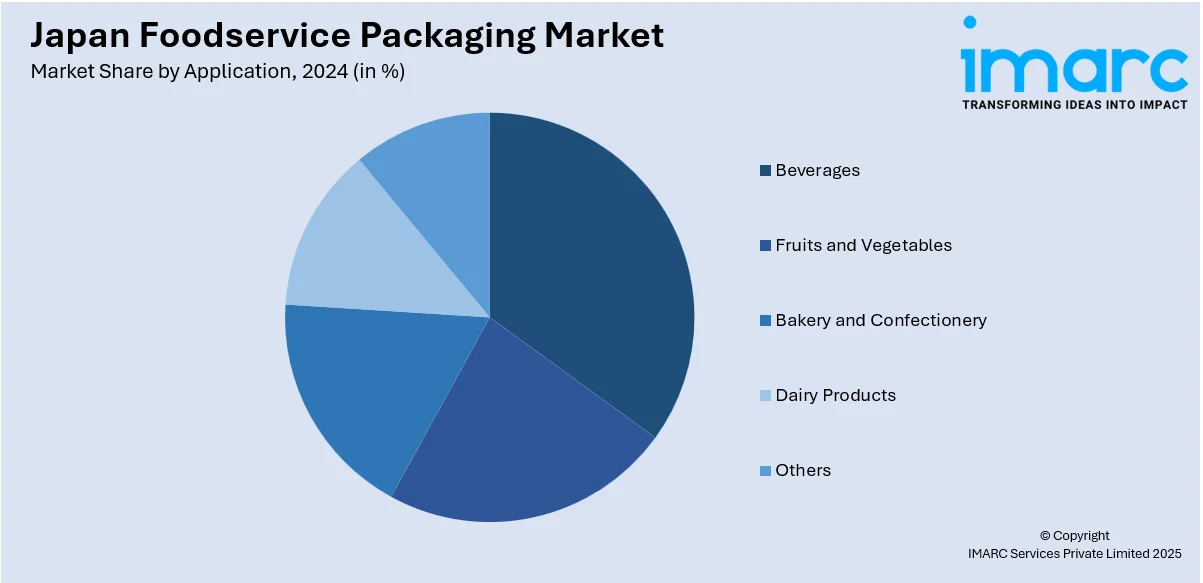
Japan Foodservice Packaging Market Size, Share, Trends and Forecast by Material, Packaging Type, Application, and Region, 2025-2033
Japan Foodservice Packaging Market Overview:
The Japan foodservice packaging market size reached USD 4.01 Billion in 2024. Looking forward, IMARC Group expects the market to reach USD 7.52 Billion by 2033, exhibiting a growth rate (CAGR) of 6.50% during 2025-2033. The heightened demand for convenience in takeaway food items is impelling the growth of the market. Moreover, increasing emphasis on sustainability is contributing to the market growth. This, along with the continuous innovation in packaging technology is expanding the Japan foodservice packaging market share.
|
Report Attribute
|
Key Statistics
|
|---|---|
|
Base Year
|
2024 |
|
Forecast Years
|
2025-2033
|
|
Historical Years
|
2019-2024
|
| Market Size in 2024 | USD 4.01 Billion |
| Market Forecast in 2033 | USD 7.52 Billion |
| Market Growth Rate 2025-2033 | 6.50% |
Japan Foodservice Packaging Market Trends:
Growing Need for Convenience and Takeaway Food
The Japan foodservice packaging market is driven by the heightened demand for convenience in takeaway food items. People are seeking takeout meals and home delivery services, which call for sustainable and efficient packaging solutions. With the trend for convenience continuing to increase, foodservice operators are implementing packaging that not only guarantees the safe delivery of food but also enriches the customer experience. Packaging solutions including single-use containers, environment-friendly materials, and temperature-controlled packaging are becoming popular. Demand for convenient-to-carry, robust, and clean packaging is prompting foodservice companies to invest in innovative packaging solutions that sustain consumer expectations without compromising product quality. This transition is driving the demand for foodservice packaging in Japan, and both international and domestic companies are answering this demand by providing advanced and sustainable solutions. The IMARC Group predicts that the Japan convenience food market size is projected to attain USD 34,086.1 Million by 2033.

Sustainability and Eco-Friendly Packaging Preferences
The increasing emphasis on sustainability is contributing to the Japan foodservice packaging market growth. As concerns regarding plastic waste and environmental concern intensify, people are rising in support of eco-packaging options. The Government and regulatory authorities are also encouraging this trend with initiatives to limit single-use plastics and recycling programs. To meet this demand, foodservice companies are switching to biodegradable, compostable, and recyclable packaging materials. These environment friendly packaging alternatives are assisting in fulfilling consumer requirements for green products as well as regulatory mandates that are increasingly stringent. Companies are looking aggressively for novel means of reducing the environmental impact of their packaging, including the use of plant-based packaging or minimizing unnecessary packaging. This increasing demand for sustainable choices is driving the market as companies strive to match their activities with customer values and environmental objectives. In 2024, Indorama Ventures, Suntory, Neste, ENEOS, Mitsubishi Corporation, and Iwatani launched the first-ever b-PET bottle made from used cooking oil in Japan.
Packaging Technology and Innovation advancements
Continuous innovation in packaging technology is propelling the market growth. Businesses are seeking to advance food quality-preserving packaging and provide additional functionality. Modified atmosphere packaging (MAP) to extend shelf life and active packaging to manage factors such as humidity and temperature are finding acceptance in the foodservice industry. These innovations are helping operators in providing fresher products to the consumers and ensure safety and quality. Furthermore, the innovation in smart packaging, which features quick response (QR) codes for product data or temperature sensors for live monitoring, is enabling greater consumer interaction and operational efficiency. These innovations are leading foodservice companies to implement innovative packaging solutions that both offer functional advantages and better consumer experiences, thus driving the overall market.
Japan Foodservice Packaging Market Segmentation:
IMARC Group provides an analysis of the key trends in each segment of the market, along with forecasts at the country and regional levels for 2025-2033. Our report has categorized the market based on material, packaging type, and application.
Material Insights:
- Plastic
- Polyethylene
- Polyamide
- Ethylene Vinyl Alcohol
- Metal
- Others
A detailed breakup and analysis of the market based on the material have also been provided in the report. This includes plastic (polyethylene, polyamide, and ethylene vinyl alcohol), metal, and others.
Packaging Type Insights:
- Paper and Paperboard
- Flexible
- Rigid
- Others
The report has provided a detailed breakup and analysis of the market based on the packaging type. This includes paper and paperboard, flexible, rigid, and others.
Application Insights:

- Beverages
- Fruits and Vegetables
- Bakery and Confectionery
- Dairy Products
- Others
A detailed breakup and analysis of the market based on the application have also been provided in the report. This includes beverages, fruits and vegetables, bakery and confectionery, dairy products, and others.
Regional Insights:
- Kanto Region
- Kansai/Kinki Region
- Central/ Chubu Region
- Kyushu-Okinawa Region
- Tohoku Region
- Chugoku Region
- Hokkaido Region
- Shikoku Region
The report has also provided a comprehensive analysis of all the major regional markets, which include Kanto Region, Kansai/Kinki Region, Central/ Chubu Region, Kyushu-Okinawa Region, Tohoku Region, Chugoku Region, Hokkaido Region, and Shikoku Region.
Competitive Landscape:
The market research report has also provided a comprehensive analysis of the competitive landscape. Competitive analysis such as market structure, key player positioning, top winning strategies, competitive dashboard, and company evaluation quadrant has been covered in the report. Also, detailed profiles of all major companies have been provided.
Japan Foodservice Packaging Market Report Coverage:
| Report Features | Details |
|---|---|
| Base Year of the Analysis | 2024 |
| Historical Period | 2019-2024 |
| Forecast Period | 2025-2033 |
| Units | Billion USD |
| Scope of the Report | Exploration of Historical Trends and Market Outlook, Industry Catalysts and Challenges, Segment-Wise Historical and Future Market Assessment:
|
| Materials Covered |
|
| Packaging Types Covered | Paper and Paperboard, Flexible, Rigid, Others |
| Applications Covered | Beverages, Fruits and Vegetables, Bakery and Confectionery, Dairy Products, Others |
| Regions Covered | Kanto Region, Kansai/Kinki Region, Central/ Chubu Region, Kyushu-Okinawa Region, Tohoku Region, Chugoku Region, Hokkaido Region, Shikoku Region |
| Customization Scope | 10% Free Customization |
| Post-Sale Analyst Support | 10-12 Weeks |
| Delivery Format | PDF and Excel through Email (We can also provide the editable version of the report in PPT/Word format on special request) |
Key Questions Answered in This Report:
- How has the Japan foodservice packaging market performed so far and how will it perform in the coming years?
- What is the breakup of the Japan foodservice packaging market on the basis of material?
- What is the breakup of the Japan foodservice packaging market on the basis of packaging type?
- What is the breakup of the Japan foodservice packaging market on the basis of application?
- What is the breakup of the Japan foodservice packaging market on the basis of region?
- What are the various stages in the value chain of the Japan foodservice packaging market?
- What are the key driving factors and challenges in the Japan foodservice packaging market?
- What is the structure of the Japan foodservice packaging market and who are the key players?
- What is the degree of competition in the Japan foodservice packaging market?
Key Benefits for Stakeholders:
- IMARC’s industry report offers a comprehensive quantitative analysis of various market segments, historical and current market trends, market forecasts, and dynamics of the Japan foodservice packaging market from 2019-2033.
- The research report provides the latest information on the market drivers, challenges, and opportunities in the Japan foodservice packaging market.
- Porter's five forces analysis assist stakeholders in assessing the impact of new entrants, competitive rivalry, supplier power, buyer power, and the threat of substitution. It helps stakeholders to analyze the level of competition within the Japan foodservice packaging industry and its attractiveness.
- Competitive landscape allows stakeholders to understand their competitive environment and provides an insight into the current positions of key players in the market.
Need more help?
- Speak to our experienced analysts for insights on the current market scenarios.
- Include additional segments and countries to customize the report as per your requirement.
- Gain an unparalleled competitive advantage in your domain by understanding how to utilize the report and positively impacting your operations and revenue.
- For further assistance, please connect with our analysts.
 Request Customization
Request Customization
 Speak to an Analyst
Speak to an Analyst
 Request Brochure
Request Brochure
 Inquire Before Buying
Inquire Before Buying




.webp)




.webp)












